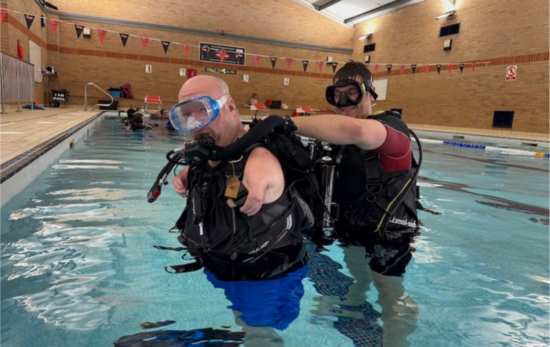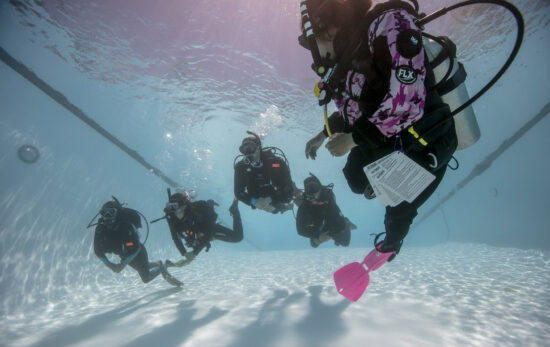From chasing sunken treasure to discovering lost cities, the underwater realm has always captivated divers and non-divers alike. This unique, and still vastly undiscovered, world deservedly plays a prominent role in plenty of Hollywood’s biggest blockbusters. But sometimes, even the best ocean movies have been known to overuse their creative license in the production process — resulting in some rather amusing scuba diving movie mistakes.
Below you’ll find just a few of the biggest scuba diving mistakes in movies you’ve probably seen. From unrealistic physics to (as-of-yet) impossible gadgets, check out some of the movie moments that make us cringe.
(Warning: Spoilers ahead.)
1. Jaws (1975)
As shark conservationists and generally pro-shark people, most scuba divers can find a lot of reasons to dislike the film Jaws. The 1970s film has turned generations of viewers into galeophobes (people with an irrational, persistent, and extreme fear of sharks). But this isn’t the reason we take umbrage with the film here. Forget the incorrect portrayal of this much-maligned animal; there is another reason Jaws makes it onto our list.
What happens?
During one of the film’s climactic scenes, Chief Brody (played by Roy Scheider) faces off against his mighty shark foe in the open ocean. After repeated attempts, he successfully shoots a scuba cylinder that had become lodged inside the shark’s mouth. This causes the scuba cylinder to explode like a bomb, resulting in an exploding shark at the same time.
Why is it ridiculous?
Even if punctured, a correctly maintained scuba cylinder does not explode like a bomb. The TV show Mythbusters experimented to see what would happen when a rifle pierced a scuba cylinder (you can check out the video here). While there are limited reports of scuba cylinders “exploding”, the pierced cylinder would have been propelled backward by the escaping pressurized air inside, if the scene had been true to science. This would have likely still resulted in the death of the shark, but it wouldn’t have been the Hollywood-style explosion witnessed in the motion picture.
2. License to Kill (1989)
James Bond is a character famous for his ability to navigate near-death experiences with hard-to-believe coolness. He’s also a badass scuba diver. However, in 1989’s License to Kill, James Bond (played by Timothy Dalton) pushes the limits of believability by performing feats the average human (or scuba diver) simply could not. Here’s why License to Kill makes our collection of the worst scuba mistakes in movies.
What happens?
During an underwater fight scene, James Bond has his regulator hose cut and needs to escape from several enemies. The answer to his predicament is to grab a spear gun and use it to latch onto a seaplane on the water’s surface. As the seaplane takes off, James Bond is quickly pulled to the surface. He then skis behind the plane, enters the plane and flies to safety.
Why is it ridiculous?
As certified divers know, a safe ascent is essential to avoid lung overexpansion injury and decompression sickness (DCS). In the movie, James Bond rapidly ascends to the surface after being at depth. He may have been able to exhale through the entire ascent to save his lungs, but he would not have removed the nitrogen from his body, putting him at risk of DCS. He then compounds his scuba diving no-no by quickly boarding a plane and heading to a higher altitude — one of the things you should never do immediately after scuba diving.
3. The Abyss (1989)
It turns out 1989 was a popular year for movies with inaccurate scuba diving scenes. In The Abyss, a James Cameron classic, a US search and recovery team joins forces with an oil platform crew in a race to recover a sunken submarine. The film has plenty of scuba diving moments — one of which will likely leave any diver scratching their head. Here’s why.
What happens?
The team needs to disarm a warhead at more than two miles (3.2 kilometers) below the surface. In the movie, the answer to this problem is a liquid breathing apparatus. Using this liquid-based equipment, Ensign Monk (played by Adam Nelson) successfully disarms the warhead. This is just before running out of air on what turns out to be a one-way trip.
Why is it ridiculous?
Breathing liquid instead of air is a novel idea. In theory, respiration using an oxygen-rich liquid instead of air may work to deliver oxygen where it is needed. However, in the process witnessed in the movie, there is no exchange of gases. This means waste products, specifically CO2, would build up in the diver’s bloodstream, which would result in a blackout for the diver.
4. The Cave (2005)
The Cave follows a team of expert cave explorers as they set out to uncover what happened to several adventurers who went missing years earlier. As the team climbs and dives their way through the underground system of caves, descending to depths exceeding one mile, they discover something they couldn’t have imagined — all while performing an impossible scuba diving feat. Can you guess what the scuba mistake in this movie is?
What happens?
As the team explores the tunnels, they are conversing with each other, sharing progress and giving each other useful information.
Why is it ridiculous?
It is possible to talk while scuba diving if you are wearing the correct equipment. For conversation, you need a full-face mask to leave your mouth free to form words and speak. However, in the movie, the divers are using in-mouth regulators which should inhibit their ability to talk, yet conversation occurs as if the regulators do not exist. (Interested in full face mask diving? Check out our specialty course.)
5. Journey 2: The Mysterious Island (2012)
Complete with giant, bee-eating birds, mammoth electric eels and an actively rising and sinking city of Atlantis, Journey 2: The Mysterious Island is hardly grounded in realism. But perhaps the most far-fetched element of the movie isn’t the mythical creatures or shifting city, it’s the scuba-related feat Hank (Dwayne Johnson) and Sean (Josh Hutcherson) complete along the way.
What happens?
From the shore, Hank and Sean need to reach the legendary Nautilus, Captain Nemo’s submarine, which rests “only 100 feet down” (about 30 meters). In answer to the problem, they create MacGyver-inspired pony bottles. They use snorkels attached to flexible, plastic bags, which contain “two hits of air.” They then enter the water, swim 100 feet (30 meters) down, using the two hits of air along the way. Of course, they successfully reach the submarine.
Why is it ridiculous?
The use of pony bottles for emergencies or short, shallow diving is legitimate. The use of homemade pony bottles, especially flimsy air-filled bags or containers, is not. Even if it was possible to successfully construct a leak-free, snorkel-bag type device, by the time you’re approaching the 100-foot (30-meter) depth, it would be useless. The volume of air inside the bag would be so compressed it wouldn’t be breathable — especially through the makeshift snorkel regulator.
Feeling Inspired To Scuba Dive the Right Way?
Having read some examples of how not to dive, it’s time to talk about how to do it the right way! Whether you’re looking to dive deeper, master dive propulsion vehicles (DPVs) or simply refresh your scuba skills, there’s a PADI eLearning course for you! Best of all, you can begin your learning right now, from your smartphone or computer.




